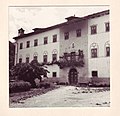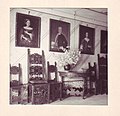Calice (noble family)
The family of the Counts of Calice belong to the Italian nobility . It originally comes from Liguria and Piedmont , subsequently from Friuli since 1401 , with headquarters in Paularo and Tolmezzo , was ennobled in 1401 and came to Gorizia in a branch after 1789 .
history
The first documentary mention was made in 1247 on the occasion of a basic exchange at the court of Milan with Pius Domenico Floreano Lombardoni del Calice from Casale . The handed down family history describes the change of the main name to del Calice ("from the chalice") with the proximity of Andrea Fillipo Lombardoni del Calice to the movement of the Waldensians and his function there. During this time, around 1300, which is laity (the blood of Christ) to the crest on the family coat of arms.
From Chieri (description of residence from 1299) Galdino del Calice and his descendants moved to Dierico in 1389, acquired land in Tolmezzo (Friuli) and Paularo , and received the mining privilege of marble mining in 1401 in the course of an ennoblement by the Patriarch of Aquilea , Antonio II Panciera the Carnic Alps north of Ligosullo . As a merchant family in the city senate of Tolmezzo represented by Leonardo (1471), Giacomo Illario (1528) and Floreano (1574), the office of Gastalden is occupied several times by Floreano (1589), Giovanni (1682) and Giovanni Domenico (1728). The family donated the church di San Pietro in Tolmezzo in 1688, the parish church of Santa Maria in 1704 and built several palazzi in Paularo, such as the Palazzo Calice Fabiano in 1494, the Palazzo Calice Screm in 1591 and the Palazzo Calice in Villafuori near Paularo in 1660. The latter was continuously expanded and is now one of the most impressive and extensive palaces in Carnia. Valesio Raimondo Calice sold it to the municipality of Paularo in 2012.
In 1672 Tomaso del Calice was raised to the status of hereditary baron of the Holy Roman Empire as part of the defense against the Turks . For political reasons and the changed balance of power in Venice, the family had to give up large parts of the possessions in Paularo in 1789. The younger branch stays in Paularo, the older one with Giovanni Nepomuceno moves to Gorizia . Through marriage, the important estate in Farra d'Isonzo came into the possession of the family, which was the economic basis for Heinrich Joseph Aloys' diplomatic career (see below). The same achieved the confirmation of the Austrian baron status in 1872 and the elevation to the count status in 1906 . The Palazzo Strassoldo-Peteani-Calice in Farra has belonged to the municipal administration since 1908.
people
Heinrich Joseph Aloys Count of Calice
(* March 31, 1831 Gorizia, † August 29, 1912 Sankt Peter bei Gorizia)
Heinrich Calice became consular eleve at the Central Sea Authority in Trieste in 1855, then came to the Ministry of Commerce and was accepted into the diplomatic service in 1859. He took part in the East Asian expedition of Rear Admiral Baron von Petz as a representative of the Imperial and Royal Ministry of Foreign Affairs from 1869-71, which resulted in the participation of China, Japan and Siam in the Vienna World Exhibition in 1873 and the establishment of trade relations between Austria and Hungary with East Asia is to be considered. Calice, who had been Consul General First Class since 1871, established the consulate service in East Asia as Minister-Resident in Shanghai. In 1874 he became diplomatic agent in Bucharest, took part in the Conference of Constantinople as envoy extraordinary and second plenipotentiary in 1876, and served as section head of the Ministry of Foreign Affairs in the central management from 1877-80. In that year he became ambassador to Constantinople and has commended the difficult diplomatic relations with the Porte for 26 years. He received the highest degree of the Order of St. Stephen.
Franz Alfred Heinrich Count of Calice
(* August 20, 1875 Vienna, † January 1, 1935 Vienna)
Like his father, Franz Calice was accepted into the diplomatic service, starting as legation counselor with his father in Constantinople in 1898, as envoy in Stuttgart in 1902 and as ambassador to the Dutch court in The Hague in 1908. In 1918 he began to head the Austrian representation in Budapest. Franz Calice became really known as an orientalist and Egyptologist. His numerous publications on Egyptian semantics or Egyptian-semantic language comparison led to his habilitation, which, however, he no longer lived through an accidental death.
Tribe list
- Pius Domenico Floreano, around 1247
- Domenico Giovanni, † before 1295
- Galdino, † before 1346
- Pius (Petrus), † 1388
- Tommasino, 1371-1432
- Leonardo, 1412-1476
- Giacomo Illario, † 1535 (beginning of the secured line of trunks)
- Gasparo, 1521-1572
- Floreano, ca.1558-1619
- Gasparo Gasparo, 1582-1629
- Tommaso Benvenuto, 1625-1694
- Floreano Giovanni, 1645-1711
- Giovanni Domenico, 1654-1733
- Giovanni Battista, 1708–1782
- Giovanni Nepomuceno, 1760-1798
- Franz Anton, 1776–1847
- Heinrich Joseph Aloys, 1825–1912
- Franz Alfred Heinrich, 1875–1935
Today around 125 descendants live as namesake and agnates in Vienna, Adelmannsfelden and London.
coat of arms
Old coat of arms: in silver a golden, uncovered goblet, in the middle of the waist a red rhombus standing on top. A pointed visor helmet, the ceilings red and gold, on the helmet a black open eagle flight.
Coat of arms 1672: In red on a green hill, a golden crown of leaves from which a golden lion grows, with his right paw swinging a golden saracen saber over him; on the helmet with red and gold covers an open black eagle flight, between them an old coat of arms.
literature
-
Genealogical handbook of the nobility , CA Starke Verlag , Limburg / Lahn
- Adelslexikon Vol. 2, 1974, p. 214; Vol. 17, 2008, pp. 141-142.
- Genealogical Handbook of the Count's Houses , B 2, Volume 23 of the complete series, 1960, pp. 56–57; B 4, volume 54 of the complete series, 1973, pp. 60-62; 15, volume 112 of the complete series, 1997, pp. 98-102; 19, Volume 146 of the complete series, 2009, pp. 18-24
- Institute for German Aristocracy Research: German Aristocracy Index, Forstweg 14, 24105 Kiel-Düsternbrook
- Reinhold Lorenz: Japan a. Central Europe, Von Solferino bz Vienna World Exhibition , 1944; BJ XVII (part 1912, L); ÖBL
- Walter Goldinger : Calice, Freiherr von, Graf von, Heinrich , in: Neue Deutsche Biographie 3 (1957), p. 94
- Meyers Großes Konversationslexikon , Vol. 3, p. 702 6th edition, L / W 1903
- Meyers Kleines Konversationslexikon , Vol. 1, p. 1034 7th edition, Leipzig Vienna 1908
- Raimondo Valesio Calice: la famiglia Calice dalla valle d`incaroio al mondo , Club Unesco di Udine 1995
- Johannes Freiherr von Franz: Stammliste of the Alice family , Cairo 2003, Nuenen 1998
Individual evidence
- ↑ Christoph Ulmer: The Villa in Friuli , accessed on November 24, 2012
- ↑ Report on the consular activity (DF) (PDF; 68 kB)
- ↑ Ägyptologische Abhandlungen , accessed on November 24, 2012
- ^ GeneAll.net





